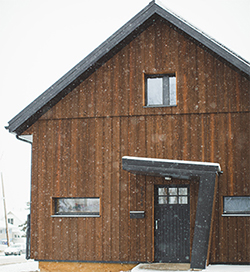Passive House Project
The Passive House serves as an example of the important role that municipalities can play in introducing new ways of building and new technologies that highlight energy conservation.
As the Energetic City, Fort St. John recognizes that an excellent source of energy is conservation. As an experiment on what can be accomplished in energy conservation – even in the north - the City embarked on a project to prove that homes here can be built to a high level of energy efficiency.
At the time of completion of the house, it was only the third certified single-family passive house built in Canada.
Background
- Over the past several years, the City of Fort St. John has made it a priority to conserve water and energy, and ultimately reduce both costs and greenhouse gas
 emissions (GHG) from its corporate operations and at the community level.
emissions (GHG) from its corporate operations and at the community level. - The City has also adopted a community-wide GHG reduction target of 12% below 2007 levels by 2030 and continues to maintain a carbon-neutral status in its corporate operations.
-
The City has worked to become an environmental leader in the Peace River region through the use of pervasive sustainable and environmental best practices. The approach is to prioritize conservation as one of the easiest and best sources of energy.
Awards and Certifications
- PHIUS (The Passive House Institute US) Certified Passive House - 2015
- Canadian Green Building Award - Regional Winner - 2016
- Northern BC Commercial Building ‘Green Award’- 2016
- North Central Local Government Association Environmental Sustainability Award - 2016
- Canadian Wood Council community Recognition Merit Award 2016
- Union of BC Municipalities Community Excellence in Leadership and Innovation Honorable Mention 2016
- LEED (Leadership in Energy and Environmental Design) Platinum Certification - 2017
What is Passivhaus?
In a nutshell, a Passivhaus (or Passive House, in North America) is a house that is almost airtight, gets most of its heating from the sun and has such an insulated building enclosure/envelope (floor, walls, roof, windows and doors) that it only requires a small amount of energy to heat and cool.
The Canadian R-2000 program has an airtightness standard of 1.5 ach50. The Passivhaus airtightness standard — a tough standard to achieve — is 0.6 ach50. The Fort St. John Passive House achieved .33. Yes, this is amazing. The revolutionary energy performance of Passive House buildings demands a rigorous and scientific approach to design and construction. Building (remember it isn’t just for houses!) heating and cooling savings of 80 – 90% happen with consideration of proper planning, efficient building shape, solar exposure, super-insulation, advanced windows, airtightness, ventilation with heat recovery, ventilation air pre-heating and thermal bridge free construction.
An EnerGuide rating is a standard measure of a home's energy performance. Ratings are calculated by professional EnerGuide rating service energy advisors from information collected during the analysis of building plans and the results of the blower door test performed once the house has been built. An average home has a rating of 65-72. The Fort St. John Passive House achieved a rating of 91. The Passive House approach aims for an optimal economic investment combined with the highest levels of comfort and indoor air quality. Even at today’s relatively low energy prices, a Passive House is the cheapest house you can build in Canada over its lifecycle.
Building Costs and Energy Data
The construction of the Fort St. John Passive House at a cost of $276 per square foot compares favourably with other average homes in Fort St. John. The average home cost in 2014 was between $250 and $350 per square foot depending on the finishing details chosen.
Costs were kept lower by choosing economical interior finishing options and there are some cost savings in not needing to buy a furnace. The monthly savings for utilities makes a passive home comparatively inexpensive.
- 33% of the passive house energy costs are offset by solar energy production.
- The hot water tank is the greatest energy user in the house. 301 kWh of electricity in an average month.
- In summer months more energy was produced than was used resulting in a credit on the Hydro bill.
- The most energy used is in the winter months. 1100 - 1200 kWh of electricity in an average cold month.
- In one year, the house used 9020 kWh of electricity.
- At BC Hydro 2016 rates $747.76 worth of electricity was used in one year (not including any fees and taxes).
-
Subtract the energy generated from the solar panels and the average cost per month on the house for electricity was $41.12. There is no gas.

